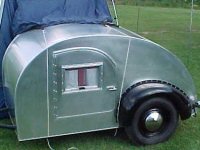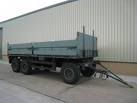Steve_Cox wrote:Wimperdink wrote:What about an articulating front wheel setup with some sort of return to center dampening system and the hitch is hard mounted to the trailer frame. It would pull like a small car behind an RV.
Harder on tires yes but no weight on the tow vehicle and proper asthetics.
Yup, they make those, or have in the past. Seems the important thing, high speed operation aside, is to get the tongue length right so the rear wheels of the tow vehicle and the turning wheels of the trailer have the right geometry to cause the tow to follow the track of the tow vehicle.
In this type of setup, you basically have a trailer with its normal axle at the towed car's rear axle, and an extra castered wheel set holding up load at the front. The track taken by the towed car cuts in severely on corners because it is so far back. It works with any length of towed car because even the shortest car is long to the rear axle.
The trailer will
not follow the track of the tow vehicle... it cuts inside on turns like any trailer.
I think the difference between how well vehicles work for this is in how well the front suspension and steering caster. It's not how they are supposed to be driven, but it works... it's certainly not what I would want to deliberately produce.
Backing up works as well as castering works in reverse; that is, lousy.
By the way, I've seen full-size truck-based SUVs flat-towed behind motorhomes... when you have a ten-ton rig, what's three more tons?
If you do want to more closely follow the track of the tow vehicle, then you must
connect a pivoting drawbar/tongue to the steering of the trailer. Then...
I think the key to coordinating the tracks taken at each axle of a steered trailer has four factors: the tongue length, the distance between the axles of the trailer, the distance from hitch to tug's rear axle, and the "steering ratio" (how much the trailer's steering wheels turn compared to how much the drawbar/tongue is turned).
The trailer's steering wheels could nearly follow in the tracks of the tug's rear wheels, but the trailer's rear wheels will not follow in the tracks of the trailer's front wheels, unless they are countersteered as well... which would not be stable at speed. This is done in low-speed stuff like the baggage trains at airports.









